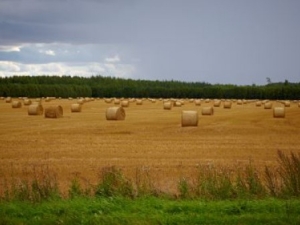Agriculture, Analytics, EU – Baltic States, Markets and Companies, Modern EU
International Internet Magazine. Baltic States news & analytics
Thursday, 25.04.2024, 18:03
Farming in the EU and the Baltic States: time for change
 Print version
Print version |
|---|
According
to Eurostat, about 171 million
hectares of land in the EU states have been used for agricultural production in
2016: it was about 40% of the EU's total land area. This supported
about 10.3 million farms and farm managers.
Although
numerous, most of the EU's
farms were small in nature, two-thirds being less than 5 hectares (ha) in size.
In contrast, the 3% of EU farms of 100 ha or more in size worked over half of
the EU's
utilised agricultural area.
Nevertheless, the mean size of an agricultural holding in the EU was
16.6 ha in 2016.
Only
11% of farm managers in the EU were younger than 40 years old, in contrast to
one third (32%) who were 65 years of age or older.
Source: Commission’s press
release (Brussels, 28 June 2018) at:
http://europa.eu/rapid/press-release_STAT-18-4298_en.htm?locale=en
Farmers’ distribution in
the EU
Farming
in the EU is broadly characterised by three distinct groups: (i) subsistence
farming, where the focus is on growing a majority of food to feed farmers and
their families (ii) small and medium-sized holdings that are generally
family-run businesses and (ii) large agricultural enterprises.
About
one third of the EU's farms in 2016 were located in Romania - nine in every
ten farms (92% or 3.1 million farms) were smaller than 5 ha, but 0.5% of farms
of 50 ha or more in size farmed over half of all the utilised agricultural area
(UAA*) in the country. Another third of EU farms was in Poland, a little bit
less in Italy (10% of the total) and in Spain (9%).
*)Note:
Utilised agricultural area is the area used for farming; it includes the
following land categories: arable land, permanent grassland, permanent crops,
other agricultural land such as kitchen gardens (even if they only represent
small areas of total utilised agricultural area). The term does not include
unused agricultural land, woodland and land occupied by buildings, farmyards,
tracks, ponds, etc.
Larger
farms in the EU -of 50 hectares or more- were common in Luxembourg (52% of
farms), France (41%), the United Kingdom (39%) and Denmark (35%). In most EU
states, a majority of UAA was concentrated on the largest farms (50 ha or more
in size).
Farmers’ efficiency
It seems that most efficient have been farmers in France, Germany, Italy, Spain and Poland (in dissending rates).
Of about EU's 10.3 million farms, 4.0 million had a standard output below € 2 000 and were responsible for only 1% of total agricultural economic output. About 300 000 farms (or 3% of all holdings) in the EU, each produced a standard output of € 250 000 or more and were responsible for a majority (55%) of the EU's total agricultural economic output in 2016.
About
one half (54%) of the standard output generated by agriculture in the EU was
from farms in France (17%), Germany (13%), Italy (12% in 2013) and Spain (11%)
in 2016. Although Romania accounted for about one third of the EU's farms, they
accounted for only 3.4 % of the EU's standard output.
In
the Baltic States, most efficient farmers are in Estonia (though fewer in the
number of farmers); there are more farmers in Lithuania (almost double so much
as in other two Baltic States) with more efficient production. In Latvia there
are more farmers than e.g. in Estonia, with quite lower efficiency.
Farming- relatively few
young farmer...
Young
farmers were particularly few - between those in Cyprus (3.3% of all farm
managers), Portugal (4.2%) and the United Kingdom (5.3%). They were more common
in Austria (22.2%), Poland (20.3%) and Slovakia (19.0%).
Nevertheless,
the youngest farm managers tended to have bigger farms in terms of area,
livestock and standard output than the oldest ones (over 65 years of age).
The
farming profession is dominated by men, with only about three in ten (29%) EU
farm managers being women. The proportion of young farm managers who were women
was lower still (23%).
All
references to the Eurostat press
release at:








 «The Baltic Course» Is Sold and Stays in Business!
«The Baltic Course» Is Sold and Stays in Business!

